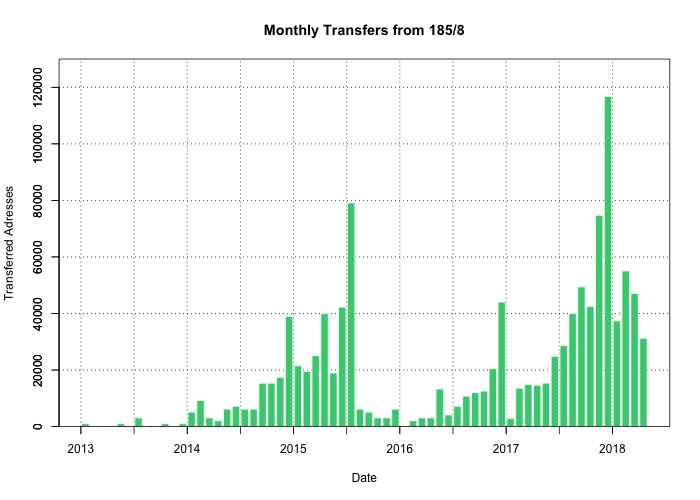RIPE distributed the last block / 22 of the last block / 8. What's next?

The distribution of IP addresses in 185/8, the last free block of RIPE, in 2012 (left) and 2018 (right), source
On April 17, 2018, the RIPE Network Coordination Center — one of five Regional Registries — distributed the last 1024 IPv4 addresses from the last block / 8 received from IANA in 2011. Although the last block 185/8 is fully distributed among European companies, but 9 million "restored" addresses (that is, addresses taken from former owners) remain in the RIPE NCC pool. According to the calculations of the Coordination Center, this will be enough for about two more years if issued at the request of local registrars for / 22 each.
At the moment, each IPv4 address is an extremely scarce product, and the last allocated IP addresses are used very intensively. Therefore, situations like the current mass blocking of IP addresses in Russia are especially unpleasant. At the peak of blocking, 18 million blocked by Roskomnadzor IP addresses corresponded to 5.5 million blocked domains - this is about 2.45% of the 223 million known domains on the Internet.
Fortunately, now the Russian regulator is gradually lifting the blockade . Now, only 14.6 million addresses remain on the RKNSHOWTIME bot's statistics, or 14.7 million on the statistics of another RKN block digest service . The difference is related to the fact that in the first case only explicitly indicated IP addresses are considered, and in the second case both IP addresses and domains are considered (some records in the Roskomnadzor unloading contain only the domain name).
')
How was the last block distributed / 8
When the RIPE NCC received the last / 8 (block 185/8, 16,777,216 addresses), about 75 million addresses remained in the RIPE pool, so that they continued to be distributed freely on the basis of local registrar (LIR) applications. But in September 2012, the only free block remained 185/8 - and then Section 5.6 of the IPv4 Address Distribution Policy in the European Region came into effect. These rules were specifically accepted when it became clear that the shortage of addresses could not be avoided.
The rules allocate a scarce resource in limited quantities (one block for each local registrar). As a result, we can say that the rules helped a lot. The last block / 8 was stretched for 5.5 years, while the previous block / 8, according to the old rules, was distributed in five months .
Below is a section 5.6 of the new rules in some abbreviations. In particular, we reduced the part of address allocation to traffic exchange points for which we reserved one / 16 range (65,536 addresses). It is distributed in blocks from / 24 to / 22, that is, from 256 to 1024 addresses.
5.6 Use of the last block / 8 (Use of last / 8 for PA Allocations)
When the RIPE NCC starts allocating the IPv4 address blocks from the last / 8 block received from IANA, the policy below will be applied.
- Block allocation for LIR from the last / 8.
The procedure for satisfying LIR applications for IPv4 addresses is as follows:
- LIR can only get one block from the last / 8 block. Block size - / 22.
- LIR will receive only one / 22 block, even if the need for addresses is much higher.
- The LIR can request this block and receive it in accordance with the address space allocation policy that was in effect at the time of the request.
- IPv4 blocks will be issued only to those LIRs that received IPv6 addresses from the upstream local registrar (upstream LIR) or from the RIPE NCC.
- The allocation of traffic exchange points (Internet Exchange Point).
- Unforeseen circumstances.
- Block / 16 will be reserved for future unforeseen purposes. If there are none, then by the time the last / 8 is consumed, this block will be distributed in accordance with clause 1.
- Post-depletion Address Recycling
These provisions relate only to the address space returned to the RIPE NCC and non-returnable to IANA.
- Any address space returned to the RIPE NCC will be allocated according to the rules described in Part 1.
- The minimum block size allocated from the last / 8 can be changed if necessary.
- If there are not enough addresses to allocate the / 22 block, the addresses will be allocated by several blocks (multiple allocations), but in a quantity equivalent to / 22.
So, for five and a half years, the RIPE NCC allocated blocks / 22 of the last / 8 according to these rules, with the exception of two blocks / 16, reserved for unforeseen circumstances and for traffic exchange points.
The essence of the new rules is that, regardless of the needs of local registrars, they were given only 1024 addresses, that is, only one / 22 block - and only when they already received an IPv6 block. However, according to statistics for 2012–2018, the rate of allocation of IPv4 addresses in Europe grew in accordance with the quadratic function. The RIPE NCC explains this by the fact that more and more local recorders have been registered .

This growth of registrations the RIPE NCC uses to predict the distribution of IPv4 address residuals
The Network Coordination Center noted an increase in the number of registrations as members of the RIPE NCC organizations that do not distribute addresses, but serve end-users. According to experts, for organizations, membership in the RIPE NCC was the cheapest way to obtain additional IPv4 addresses for its own infrastructure.
It also turned out that the incentives for the transition to IPv6 also do not work. Most organizations that registered IPv6 address ranges before receiving an IPv4 block did not use them at all . Moreover, in order to avoid wasting IPv6 address space, in March 2015, RIPE completely removed the requirement for mandatory registration of an IPv6 block.
In November 2015, RIPE prohibited the registration of additional local registrars by members of the RIPE NCC, but this did not help either, so in May 2016 the restriction was lifted. At this point, organizations started registering new legal entities in order to obtain deficient blocks / 22. Reportedly, a certain member of the RIPE NCC was able to get 66 units / 22, although only one was issued for each local registrar. The restriction was removed, because we decided that it would be better for organizations to take advantage of the legal loophole in the current procedure, and not to look for workarounds.
This is how the scarce resources were distributed across countries ( statistics file ). To simplify the figures on the map are rounded to / 22, although many blocks were divided into / 23 and / 24.

Some anomalies can be seen on the map: for example, unusually few blocks are allocated to organizations from Belgium, Portugal and Belarus, compared with their more “enterprising” neighbors.
Only by 2015, the RIPE NCC specialists realized that a large number of blocks / 22 immediately after allocation change their owner and within a few days or weeks they transfer to another registrar (transfer). The regulator then banned transfers for IPv4 addresses until 24 months after allocation . But judging by the schedule of monthly transfers , this also did not help, it just froze transfers of fresh ranges for two years.

When will the last IPv4 addresses end?
As already mentioned, there are about 9.03 million IPv4 addresses in the RIPE NCC pool, which will be enough for about two more years. Of these, four million are 1/5 of the 20 million addresses that the IANA (Internet Address Space Administration) restored and distributed to five regional registries over the past four years. RIPE took another 5 million addresses on its own, having conducted a “roll call” of organizations. Under the terms of the procedure , if no response was received from the owner, then his IP addresses were withdrawn.
At the same time, providers have learned to cope with the lack of address space. Many have mastered the address translation (NAT) technique when users are allocated private IPv4 or IPv6 addresses, using fewer global IPv4 addresses.
If you extrapolate the schedule, then the current pool will be enough until about May 2020.
Offers for the sale or lease of IPv4 are discussed on the forums of providers and on Habré . Apparently, renting IPv4 addresses has become a good business.
Recycling IPv4 and IPv6
Many organizations have registered IPv4 ranges that are huge at the present time, which are practically not used and are not going to be given (for example, 16.8 million addresses in the block 44.0.0.0/8, registered allegedly for amateur radio , or 218 million IP addresses United States Department of Defense: 11.0.0.0/8, 22.0.0.0/8, 26.0.0.0/8, 28.0.0.0/8, 29.0.0.0/8, 30.0.0.0/8 and 33.0.0.0/8).
Other blocks are used very intensively. For example, the visualization of the Hilbert curves well shows how the address space of approximately 4.2 billion (2³²) addresses is allocated.

IPv4 address space allocation, April 2018 ( clickable )
For comparison, this is how the distribution of IPv6 address space looks today.

IPv6 Address Space Distribution, April 2018
We announce the action “More cyber defense to sports”!

GlobalSign joins the celebration of the most ambitious event of all athletes and football fans - WORLD FOOTBALL CHAMPIONSHIP 2018 and GIVEN 1 YEAR SSL PROTECTION! *
Terms of action:
* When you purchase any one - year DV-OV or EV -level SSL certificate , you get the second year as a gift.
• The promotion applies to all sites of sports.
• The promotion is valid only for new orders and does not apply to partners.
• To take advantage of the offer, send a request on the website with the promotional code: SL003HBFR .
The promotion will last until July 15, 2018.
You can get additional information on the promotion from GlobalSign Russia managers by phone: +7 (499) 678 2210.
MORE PROTECTION with GlobalSign!
Source: https://habr.com/ru/post/355006/
All Articles